


Experiments with magnetic levitation
Diamagnetic Levitation ![]()
This is an experiment where a magnet will float between two diamagnetic plates. No electromagnets are needed, no sensors are needed, no current source is needed. Only one other magnet is needed to help balance the force of gravity.
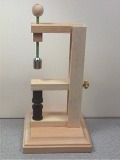
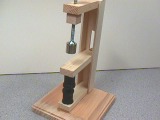

The fixture seen here was purchased from www.magnetlevitation.com and is a very well assembled and thought out demonstrator of diamagnetic levitation. As you remember, diamagnetism is a property of some materials where they repel magnetic fields, both North and South poles. Is it possible to make a magnet float on top of a diamagnetic piece of material? Is it possible to make a piece of diamagnetic material float on top of a magnet? The answer is YES to both of these questions.
With this fixture, we have a magnet that will float between two pieces of pyrolytic graphite, a fairly good diamagnetic material. If it is too close to the graphite on the bottom, it will rise. If it is too close to the graphite on the top, it will drop. Eventually, it will find a happy mid-point where it will hover, or levitate, stably. Since the magnet is a bit heavy, though, a lifter magnet is needed to counteract the force of gravity on the floater magnet. This lifter magnet is seen here at the top of the photo. It is a 1/2" diameter by 1/2" long cylindrical NIB magnet, stuck to the head of a flat-head screw. The screw is used to adjust the distance between the lifter magnet and the floater magnet.
I started the set-up by attaching the lifter magnet to the end of the flat-head screw. Then I moved the adjustable arm, holding the top graphite disk, so that the distance between the graphite disks is about 7mm.
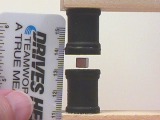
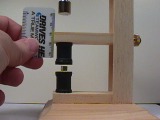
Next, I adjusted the screw of the lifter magnet to be about 20mm above the top surface of the adjustable arm. Then I placed the small cube magnet between the graphite disks to see what would happen.
If the lifter magnet was too close to the floater magnet, the floater magnet would be touching the top disk.
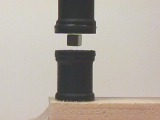
If the lifter magnet was too far away from the floater magnet, the floater magnet would be touching the bottom disk.

By carefully adjusting the lifter magnet, I was easily able to get the floater magnet to hover between the two disks as shown here.
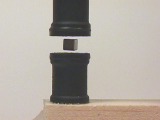
I even tried tipping the fixture at an angle to see what would happen. The floater magnet would get close to the edge of the disk and start to drop down since it didn't have the diamagnetic support beneath it.
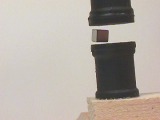
The two black objects are small spools to which the graphite disks are glued.
Hats off to Seth Troutner for making such an elegant fixture for demonstrating diamagnetic levitation!
He notes a couple of things you should be aware of:
a) temperature variations will cause
the floater magnet change its position up or down
b) nearby magnets, steel screws and
hinges or a steel table surface will have an affect on the
floater magnet
The thing to
do is to set this up in the middle of a wooden table.
After you have it working, then you can start having even more fun
trying things like:
1) how will a
magnet in your hand about 8" from the floater magnet
affect it? (rotate it in your hand)
2) what if you place another
magnet below the table?
3) try placing the fixture onto
a steel desk
4) what happens when the room
temperature increases?
5) what happens when the room
temperature decreases?
6) try a different shape for
the floater magnet, like a disk or a ring magnet
7) try slipping various pieces
of material underneath the lifter magnet like aluminum,
copper, brass, lead, paper, an American quarter, a Canadian quarter, wood, your
fingers, a shallow glass dish of water, a shallow glass dish of ice, plastic, a
CD, etc. What happens to the floater magnet?
8) try building your own
levitator
9) try using your fingers for
the top and bottom diamagnetic material
10) try building a seismometer
using a diamagnetic levitator (or using two of them)
Here are some other links to diamagnetic levitation experiments:
www.magnetlevitation.com
www.physics.ucla.edu/marty/diamag/
davidfiedler.com/levitation.htm
www.hep.princeton.edu/~mcdonald/examples/diamagnetic.pdf
www.scitoys.com/scitoys/scitoys/magnets/suspension.html
www.scitoys.com/scitoys/scitoys/magnets/pyrolytic_graphite.html
www.graphitemachininginc.com/page7.htm
www.graphite-eng.com/